 |
|
|
BiblePlaces Newsletter
Vol 3, #5 -
October 13, 2004
Still in the making is Part 2 of "Electronic Maps for Bible
Teaching." Completion of that review has been slowed by final work
on the new "Historic Views of the Holy Land" CD series due out in
November. In this issue, I've decided to give you a peek at some
of the "new" stuff.
The Historic Views of the Holy Land series is a companion
collection to the Pictorial Library of Bible Lands. The latter
series shows the biblical sites as they are today.
Unfortunately, that is not always very similar to the way things were in
antiquity. The changes in the last 100 years have been major.
For this reason, drawings, maps, photographs from long ago can be quite
helpful in more accurately illustrating biblical times and life.
One of the CDs in the new series is a collection of photographs from
biblical sites in Israel, Egypt, Turkey, and Greece from the 1890s.
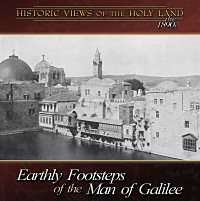 These images capture scenes that do not exist today. This
newsletter includes some of those photographs, together with the
authors' explanations of the scene. I think you'll find the
captions interesting, but many of the photos can be used to illustrate
more than what the caption describes. Next month, the complete
collection of 400 high-resolution photographs and their captions will be
available for purchase, together with some other gems I've been working
on for the last couple of years.
These images capture scenes that do not exist today. This
newsletter includes some of those photographs, together with the
authors' explanations of the scene. I think you'll find the
captions interesting, but many of the photos can be used to illustrate
more than what the caption describes. Next month, the complete
collection of 400 high-resolution photographs and their captions will be
available for purchase, together with some other gems I've been working
on for the last couple of years.
Todd Bolen
Editor, BiblePlaces.com
Assoc. Professor, The Master's College
Israel
Bible Extension (IBEX), Judean
Hills, Israel
News
There have been a number of interesting news stories related to
biblical sites and artifacts in the last month. These include:
The Silver Amulets: A New Report - The NY Times reports on a new study of
the earliest Scripture verses ever found.
The
Temple Mount: Another Warning of Collapse - Ramadan begins in a few days
and Israeli officials that recent construction could cause the area of
"Solomon's Stables" to collapse when hundreds of thousands of Muslims come to
pray.
The James Ossuary - more thoughts on its authenticity by
Hershel Shanks and
Ada Yardeni.
A bit more dated are the stories about the
dump on the Temple Mount and the discovery of the
Cave of John the
Baptist. But if you haven't already, you might be interested in some
photos of the dump and a few of my
thoughts on the cave.
What are the best sites for the latest news on the biblical
world? The Bible and Interpretation
and PaleoJudaica.com are my
two favorite.
|
|
|
|
|
Free
High-Resolution Photos The following
photographs and captions are from a book published in 1894 entitled,
"Earthly Footsteps of the Man of Galilee." I chose the
following photographs as representative of various places in the life of
Christ. Though black and white, I think you'll agree that some of
these photographs are more powerful in communicating than color photos
available today. The captions are from the original work, but have
been abbreviated here. Each photograph is linked to a
higher-resolution version and may be used freely for personal and
educational purposes. |
|
|
|
|
|
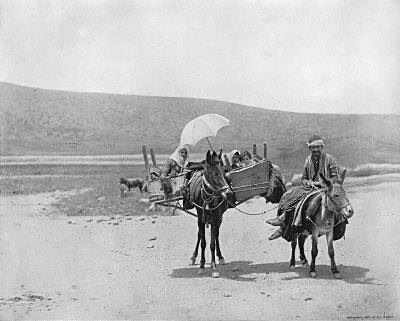
Click picture for higher-resolution version. |
|
Family Traveling in Galilee
As we made our way through Galilee, we met on the
road a family as you see in the picture. A box is strapped on each side
of the mule; a woman holding an umbrella is in one box and two
bright-faced little children are in the other. The husband rides
sidewise upon a donkey, holding to the mule by a line made up of chain
and rope. This family probably belongs to the higher classes among the
peasantry of the country. It was in the days of Christ that families
journeyed in this way from one end of the land to the other. |
|
Camels Feeding at Nazareth
The Bedouins live by cattle breeding, and possess immense
herds of sheep and camels. The little town of Nazareth is often harrassed
by the quarrels of the Arab chiefs and the predatory attacks of the
Bedouins. Their herds feed upon the grassy slopes, the camels seeking the
sunshine, or loaded with tents and the multifarious furniture of the camp,
go roaming abroad "for fresh fields and pastures green." To the stranger
the slow-paced camel with his soft-cushioned feet, his noiseless solemn
tread, imperturbable patience imprinted upon his dun colored face, seems a
picturesque and amiable animal, but to one who knows him well he is cross,
discontented and often treacherous. |
|
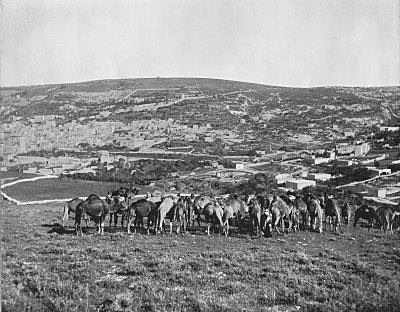
Click picture
for higher-resolution version. |
|
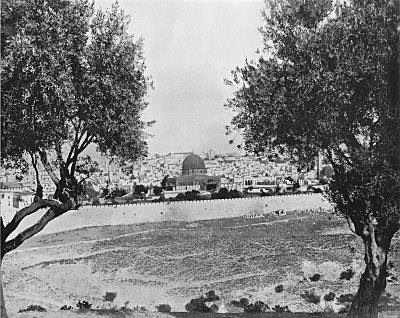
Click picture
for higher-resolution version. |
|
View of Jerusalem
A high battlemented wall, in some places nearly eighty
feet high, encompasses the city. The red rays of the setting sun shed a
halo round the Castle of David, and tips with gold each "tapering
minaret" and gilds each dome of mosque and church. The Mosque of Omar,
the most splendid mosque in the world, encrusted with encaustic tiles of
gorgeous colors, and surmounted by its graceful dome, the dazzling
whiteness of its pavements and fountains, and, most of all, its sacred
associations, make it one of the most interesting and charming spots on
earth. The architectural features of the scene are wholly changed since
the boy from Nazareth looked on Jerusalem. But the hills, the valleys and
the sky are the same. Here He walked and wondered, the simple lad from
Galilee. |
|
Jewish Wailing Place
The pinnacles have fallen, the temple has been destroyed;
almost every mark of the old Jewish occupancy of this sacred site has been
removed, but against the southwestern wall of the temple area a paved spice
is given to the Jews, where they may pray and read from their prophets and
wail out their woe under the very shadow of the area on which once stood
the pride of this nation, the temple of God. On Friday afternoon, March
13, 1863, the writer visited this sacred spot. Here he found between one
and two hundred Jews of both sexes and of all ages, standing or sitting,
and bowing as they read, chanted and recited, moving themselves backward
and forward, the tears rolling down many a face; they kissed the walls and
wrote sentences in Hebrew upon them. |
|
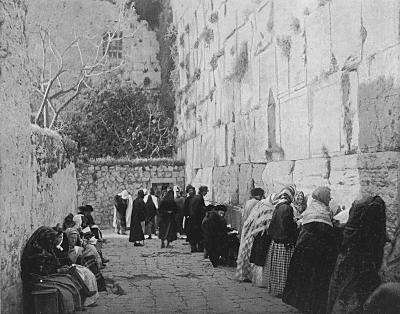
Click picture
for higher-resolution version. |
|
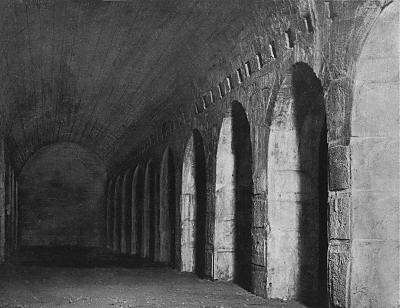
Click picture
for higher-resolution version. |
|
Stables of Solomon
The view which we present represents the vaults under
the temple area. They are called Solomon's stables. Just why, nobody
knows. A traveler mentions them as capable of holding two thousand
horses. It is probable that they were used in the time of the Crusaders
as stables. The floor of this vault is a little over thirty-eight feet
below the level of the pavement above. The semicircular arches are eleven
feet five inches in span and five feet nine inches in height. The aisles
open from the south to the north. While these vaults are not supposed to
date earlier than the Byzantine period, the stones of which they are
constructed evidently belonged to buildings of an earlier period-- as far
back as Herod, and perhaps Solomon. |
|
Crossing the Jordan
In passing from Peraea on the east of the Jordan to
Jerusalem Jesus crossed the Jordan. We do not know what his route was, but
he probably went as far south as to a point opposite Jericho, because from
the ford over against Jericho there is a road to Bethany and Jerusalem.
There are but two old bridges spanning the Jordan. Dangerous as the river
is, it offers an extraordinary number of fords. To cross a ford of the
Jordan is a common occurrence still. Dr. Thomson says: "Just there it is
broad and not more than four feet deep, so that the villagers were
continually fording it; men, women, children, returning home from their
fields to the east of the Jordan; a rural scene curious as rare. Sheep,
goats and even donkeys had to swim, and it required the constant care of
the shepherds to prevent their being carried down the stream together.
Cattle and horses came boldly across and so did the men, but the women and
children needed the help of the men, who brought them safe to shore." |
|
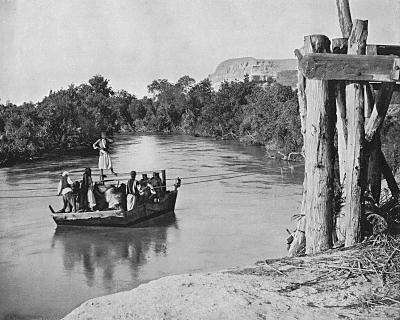
Click picture
for higher-resolution version. |
|
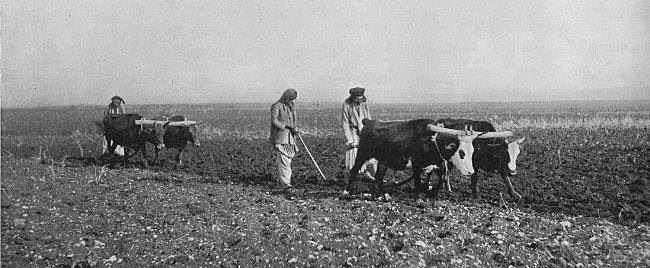
Click picture
for higher-resolution version.
Plowing in Plains of Jezreel
Passing through the vast Plain of Esdraelon, which
extends across Central Palestine from the River Jordan to the
Mediterranean Sea, Joseph and Mary would see the great battle field of
Syria. In this plain Deborah and Barak conquered the army of Jabin under
Sisera. Here also, on the southern edge of the plain near Megiddo,
Josiah, King of Judah, was defeated and slain by Pharaoh Necho, King of
Egypt, on his way to the Euphrates. In the picture we look westward,
facing Carmel and the Mediterranean. We were here on the 4th of May, in
1894. Our dragoman asked the people, whom in the picture we see plowing,
if they would stop long enough for us to take a photograph. For the usual
"Baksheesh " they granted his request. |
|
Ruins of Capernaum As the Dead
Sea is girdled by an almost constant hedge of driftwood, so the Sea of
Galilee is girdled by a scarcely less continuous belt of ruins--the drift
of her ancient towns. In the time of our Lord she must have mirrored
within the outline of her guardian hills little else than city walls,
castles and synagogues. Here in this centre of life and influence Jesus
laid the foundations of his spiritual kingdom, based upon love-- upon
love to himself as the manifestation of God. "Lovest thou me?" And when
Peter confessed his love Jesus commissioned him to "feed" his "lambs," to
"tend" and to "feed" his "sheep." What a lovely frame for this divine
picture is the Sea of Galilee with its placid waters, with the Gadarene
hills beyond, and the blue sky overhead! |
|
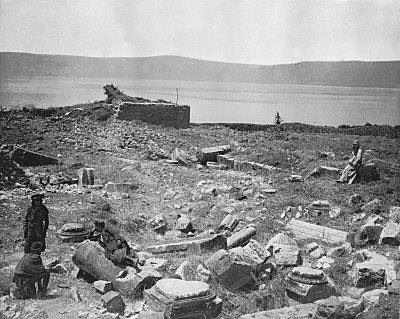
Click picture
for higher-resolution version. |
|
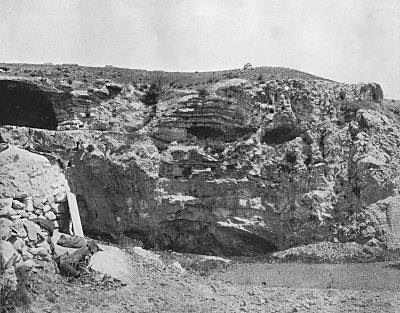
Click picture for
higher-resolution version.
|
|
Grotto of Jeremiah
Since the visit of the Empress Helena to Jerusalem in the fourth
century the tomb of Christ has been claimed by many to be in the Church of the
Holy Sepulchre. Others insist that the Church of the Holy Sepulchre was inside
the walls of Jerusalem at the crucifixion, but that Christ was crucified outside
of the wall-- many believing the tragedy to have taken place west of the hill
known as Jeremiah's Grotto. The site is strikingly appropriate. From the walls
of the city and from the temple area the terrible scene on Calvary could have
been witnessed. In the sight of the great city and the hills about He was
"lifted up"-- the Lamb of God slain for the salvation of the race. There is no
doubt but that a growing number of people accept the Grotto of Jeremiah as the
place of our Lord's burial. |
|
FORWARD THIS NEWSLETTER
Please feel free to pass this newsletter link on to others.
They can subscribe to this newsletter
here. Email addresses will never be used for any purpose
other than this newsletter.
To subscribe or unsubscribe to this newsletter,
click here.
|
|

